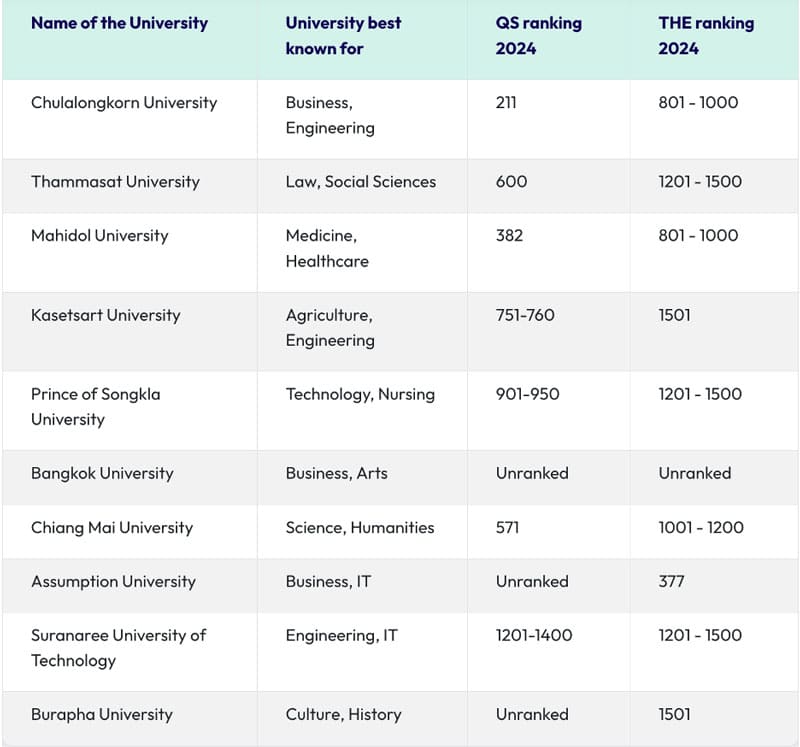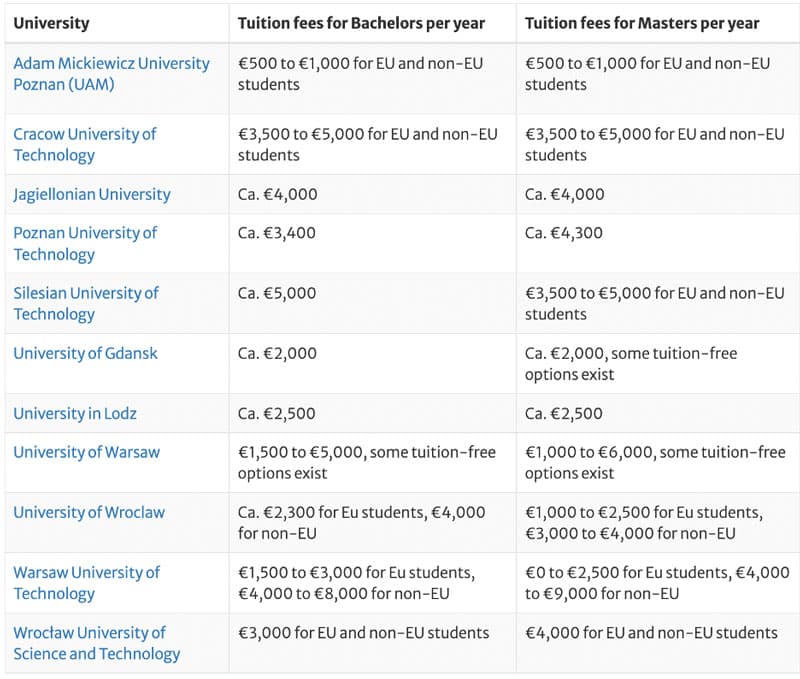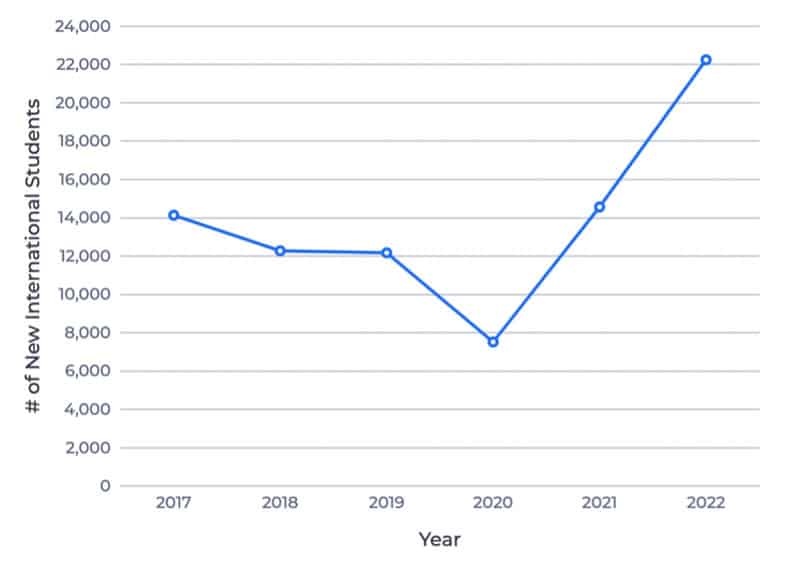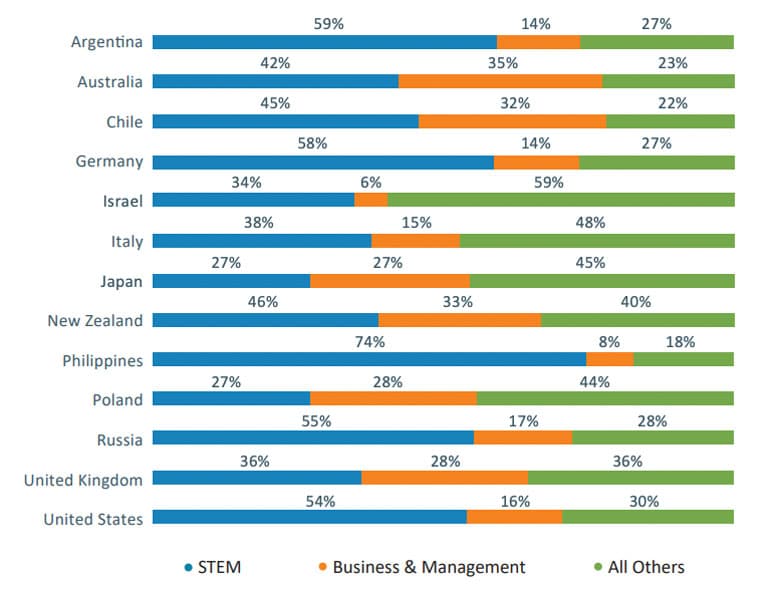A growing body of industry research shows that in 2024, international students are considering a wider range of destinations, motivated by such factors as ease of getting a visa, post-study work opportunities, and affordability.
Today, our focus is on three alternative destinations that have – relatively quietly – been attracting considerably more student interest than in the past.
These destinations are Thailand, Poland, and the Philippines, countries that are all attractive in terms of affordability as well as strengths unique to their location and education system.
Please note: Cost of living and study costs change fairly regularly, as do visa requirements. It’s important to check with individual institutions and government officials for the most current information in these respects.
THAILAND
Increased demand from China
According to Thailand’s Office of the Permanent Secretary, Ministry of Higher Education, Science, Research, and Innovation, more than 30,000 international students were enrolled in Thai universities in in 2022, up from 25,100 in 2019. Since 2009, foreign enrolments in Thai universities have grown by about 2,000 per year thanks largely to increased demand from China.
The number of Chinese students studying in Thailand has doubled within the past five years to over 20,000, and University World News reports that 60% of foreign students in Thailand (as well as Malaysia) are Chinese. Myanmar and Cambodia are the next largest senders of students to Thailand, but they sent less than 5,000 students each in 2022.
The affordability advantage
Thailand has a compelling competitive advantage in 2024: affordability.
Thailand is not only more affordable than the Big Four destinations of Australia, Canada, the UK, and US, but it is also less expensive – in terms of tuition and living costs – than the top Southeast Asian destinations of Malaysia and Singapore. Students need only to prove they have savings of US$360 when applying for a Thai student visa – an indication of just how affordable the country is to live and study in. (By contrast, students need savings of at least US$20,000 to cover tuition and living when applying for a visa for study in Australia, Canada, and US).
In terms of programme costs, bachelor’s degrees in Thailand range from about US$1,775 to $1,900 a semester, while master’s run from about US$2,320 to $2,500. Unipage.net provides the following table showing average tuition.

Students can live on a much smaller budget in Thailand than in many destinations. QS notes:
“Those on a tight student budget will be able to live on 650 baht (US$20) a day, covering food, transport and accommodation. For those looking to do some travelling and exploring while undertaking study in Thailand, you will likely need to budget around 1500 baht (US$46) per day.”
QS cautions, however, that living costs are higher in major cities like Bangkok.
Quality education offerings
Thailand isn’t just competitive on the basis of cost: it also has some very good universities and highly ranked programmes. For example, two Thai universities are ranked in the Top 100 in the QS Asia University Rankings 2024: Chulalongkorn University (#44) and Mahidol University (#51). Chiang Mai University also ranks highly at #102.
On the global QS 2024 rankings, these are the Thai universities in the top 100:
- Chulalongkorn University: #211
- Mahidol University: #382
- Chiang Mai University: #571
- Thammasat University: #600
- Kasetsart University: #751-760
- Prince of Songkla University: #901-950
- Khon Kaen University: #901-950
- King Mongkut’s University of Technology Thonburi: #951-1000
Beyond those overall rankings, the following chart shows that several Thai universities perform well in specific subject areas.

Overflow from students failing China’s ultra-competitive exams
Studying in Thailand is part of a larger trend of Chinese students choosing to study in Asia if they fail their very competitive postgraduate exams. University World News has reported that:
“Yangyang Study Abroad Private education consultancy surveys in China put the proportion of applicants who fail the postgraduate exam and then apply to universities in Asia at between 40% (estimated by the agency) and 66% (estimated by other lesser-known agencies).”
Transnational Education (TNE) is part of Thailand’s plan to become a regional education hub
Over the past five years, TNE activity has been intense in Thailand, and the Thai government sees foreign partnerships and the establishment of branch campuses in Thailand to be a key means of attracting more international students from the region. The UK is particularly active in this regard in Thailand, and there now more than 120 active collaborative agreements between British and Thai universities.
Thousands of Thai students are abroad but high costs are dampening demand
At the same time as Thailand is attracting more inbound students, it is also sending out tens of thousands (more than 30,000 in 2022). However, agents are noticing more hesitancy this year among Thai students considering study abroad. Speaking during StudyTravel’s Alphe Asia conference in February 2024, Sethaphol Rutrakool, president of the Thai education consultancy TIECA, said:
“I think that since the pandemic, the market in Thailand has recovered, but in 2024 it is not so good. Because of inflation, the costs of everything have gone up – the costs of homestays, tuition fees and everything while the purchasing power of the students and parents is not fully back yet. So, I think it’s kind of a tough situation right now. It’s going [to] slow down from what I’ve seen for the remainder of this year and maybe next year as well.”
POLAND
Over the course of the past decade, the number of international students in Poland has tripled and last year reached a record-high of over 100,000 according to the education magazine Perspektywy. A total of 102,200 international students were registered in the education ministry database for the 2022/23 academic year and about 9% of all students in Poland’s universities are now foreign.
Poland offers over 300 English-taught university programmes, an advantage that appeals to a large segment of international students.
Steep rise in Ukrainians
A key reason for the increase is a significant rise in the number of Ukrainian students, many of whom have left their country due to Russia’s invasion. Nearly 50,000 Ukrainians are studying in Poland and account for nearly half of all foreign students.
But as reported in NotesfromPoland.com, Poland is also attracting students from a wide range of other countries, including Belarus (12,000), Turkey (3,800), Zimbabwe (3,600), India (2,700), Azerbaijan (2,500), Uzbekistan (2,100), China (1,800), Kazakhstan (1,700), and Nigeria (1,600).
The presence of so many Zimbabweans is interesting – there are more Zimbabwean students in Poland than in Canada (1,425), the US (1,790), or Australia (1,665), despite these destinations’ more intense recruiting in Zimbabwe over the past couple of years.
Of the 100,000+ international students in 2022/23, Perspektywy magazine notes: “This reflects the huge amount of work done by Polish higher education in the last 19 years … when Poland joined the EU in 2004 it had only 8,800 foreign students … just 0.5% of all students at the time and the lowest relative figure in Europe.”
Affordability
Poland is an affordable destination compared to many in Europe. Study.eu provides the following illustrative chart showing tuition fees at several major Polish universities:

The Polish government says that international students can expect a cost of living of about €330 (US$350) a month, though living in cities can be more expensive. More information can be viewed here.
The fee for a student visa application is €80 (US$85). In terms of proof of funds, a student must show they have 776 PLN (US$190) plus tuition for each month of their stay in Poland plus enough for return travel back to their country. They must also show they can pay for accommodation.
12 unis in the Top 1,000
There are close to 400 state and private universities in Poland. Two Polish universities are in the top 500 in QS’s 2024 World University Rankings: University of Warsaw (#262) and Jagiellonian University (#304). Overall, these are the Polish universities in the top 1,000:
- University of Warsaw: #262
- Jagiellonian University: #304
- Warsaw University of Technology: #571
- Adam Mickiewicz University, Poznań: #731-740
- Poznan University of Life Sciences: #801-850
- Gdańsk University of Technology: #851-900
- AGH University of Krakow: #901-950
- Nicolaus Copernicus University: #901-950
- University of Wroclaw: #901-950
- Wroclaw University of Science and Technology: #901-950
- University of Gdańsk: #951-1000
- University of Lodz: #951-1000
PHILIPPINES
The Philippines is a crucial source of students for many destinations. It is now Canada’s third largest market behind only India and China, sending 48,870 students in 2023, 50% more than in 2022. It is Australia’s fourth largest market after China, India, and Nepal, with 48,300 students enrolled in 2024. Australia has been expanding its Filipino student population even faster than Canada has – the total for 2024 is up 194% over 2023 and represents a massive jump of 469% since 2019.
But the Philippines is also an attractive destination for a growing number of students, even though international students make up only 1% of the total student population. In 2022, the Philippines hosted 22,250 international students, 53% more than in 2021. As in Poland, international students have many English-taught programmes to consider in the Philippines.

STEM programmes draw the most students
Interestingly, the Philippines is enrolling most of its international students to STEM programmes. As you can see from the chart below, STEM students make up a larger proportion of the overall student population in the Philippines than they do in any other destination represented in the data.

Indian students’ growing interest in the Philippines
The Philippines’ international enrolment growth has been largely driven by Indian students. In 2022, these were the top five markets for universities in the Philippines:
- India: 16,010
- China: 4,460
- Nigeria: 1,930
- South Korea: 144
- Thailand: 137
The Economic Times notes: “While traditional destinations like the UK, US, Australia and Canada remain popular [for Indian students], other countries like Uzbekistan, Philippines, Russia, Ireland, Kyrgyzstan and Kazakhstan are gaining interest.”
ApplyBoard points out that once a destination attracts a critical mass of Indian students, it tends to expand its international student population at an increasingly rapid rate:
“Once Indian students penetrate a market, history tells us that the market will skyrocket in popularity. Not just among Indian students, but all international students.
Take the UK for example, which hosted 18,000 Indian students in 2017. Today, the UK is projected to welcome over 100,000 new Indian international students next year, which will make India the UK’s number one source market.
We will be watching the Philippines closely to see if this spike in Indian interest is the catalyst of quick growth.”
Affordability
International students can expect to pay €500–€2,000 (US$530–$2,030) per year in tuition – making the Philippines one of the most affordable study abroad destinations in the world, especially considering that the cost of living ranges from €650–€1,000 per month (US$692–$1,065).
The visa application fee is US$100 plus $40 for a compulsory registration card. There is no set amount required for proof of financial means, but students must present evidence they can afford their course of study, accommodation, and living expenses while in the Philippines.
QS rankings
Five universities in the Philippines feature in QS’s 2024 World University Rankings:
- University of the Philippines: #404
- Anteneo de Manila University: #563
- De La Salle University: #681-690
- University of Santo Thomas: #801-850
- University of San Carlos: #1201-1400
The allure of alternative destinations
The costs of living and studying – plus hefty requirements for proving sufficient financial resources – are making it impossible for thousands of students to study in the leading English-speaking destinations. But strong demand for study abroad remains, and students are proving themselves quite willing to travel to emerging destinations to earn a foreign degree at a cost that won’t leave them (and their families) desperate for cash.
Thailand, Poland, and the Philippines are just three of the alternative destinations enrolling many more students than in the past on the basis of affordability. Other host countries that have attracted significantly more international students over the past few years include Mexico, the Netherlands, Russia, and Japan.
For additional background, please see:
Source